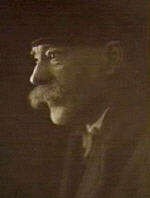
Frederick McCubbin (25 February 1855 – 20 December 1917) was an Australian painter who was prominent in the Heidelberg School, one of the more important periods in Australia's visual arts history.
McCubbin was born in Melbourne, the third of eight children of baker Alexander McCubbin (from Ayrshire, Scotland) and his English wife Anne, née McWilliams. McCubbin was educated at William Willmett's West Melbourne Common School and St Paul's School, Swanston Street. He later worked for a time as solicitor's clerk, a coach painter and in his family's bakery business while studying art at the National Gallery of Victoria's School of Design, where he met Tom Roberts and studied under Eugene von Guerard. He also studied at the Victorian Academy of the Arts and also exhibited there in 1876 and again from 1879 to 1882, selling his first painting in 1880. In this period, after the death of his father, he became responsible for running the family business.
By the early 1880s, McCubbin's work began to attract considerable attention and won a number of prizes from the National Gallery, including a first prize in 1883 in their annual student exhibition. By the mid-1880s he began to concentrate more on painting the Australian bush, the works for which he became notable.
In 1883, McCubbin received first prize in the first annual Gallery students' exhibition, for best studies in colour and drawing. In 1888, he became instructor and master of the School of Design at the National Gallery. In this position he taught a number of students who themselves became prominent Australian artists, including Charles Conder and Arthur Streeton.
McCubbin married Annie Moriarty in March 1889. They had seven children, of whom their son Louis also became an artist. A grandson, Charles, also became an artist.
McCubbin continued to paint through the first two decades of the 20th century, though by the beginning of World War I his health began to fail. He travelled to England in 1907 and visited Tasmania, but aside from these relatively short excursions lived most of his life in Melbourne.
In 1901 McCubbin and his family moved to Mount Macedon, transporting a prefabricated English style home up onto the northern slopes of the mountain which they named Fontainebleau. It was in this beautiful setting that he painted The pioneer which was painted in 1904 amongst many other works and this is the only place that McCubbin ever painted fairies. The house survived the Ash Wednesday fires and stands today as a testament to the artist. It was at Macedon that he was inspired by the surrounding bush to experiment with the light and its effects on colour in nature.
In 1912 he became the founding member of the Australian Art Association.
McCubbin died in 1917 from a heart attack.